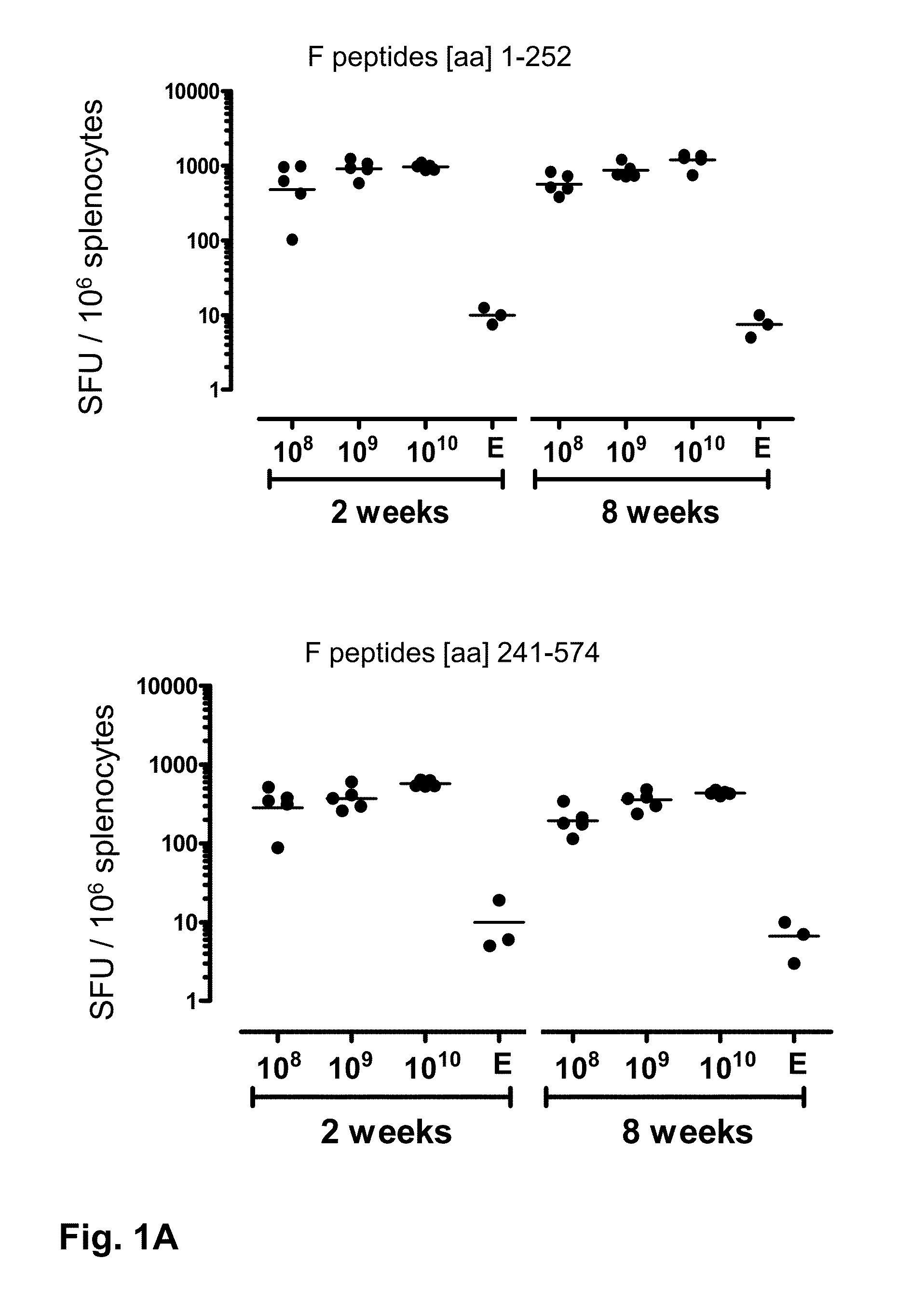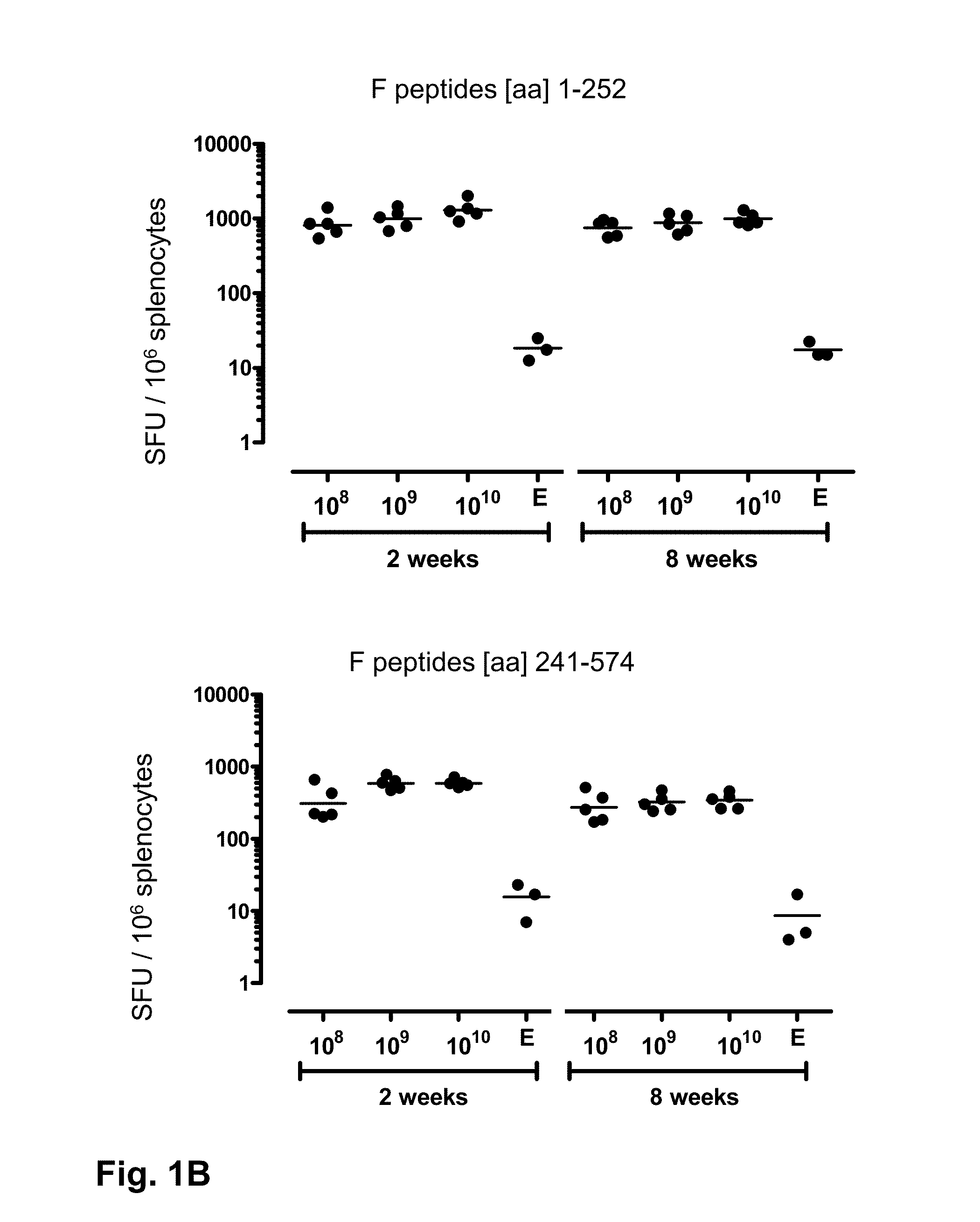Vaccine against rsv
a technology of respiratory syncytial virus and vaccine, applied in the field of biotechnology and medicine, can solve the problems of high cost of such monoclonal antibodies, the requirement for hospitalization, and the inability to use them for prophylaxis in the at-risk population at large scale, and achieve the effect of improving the efficacy
- Summary
- Abstract
- Description
- Claims
- Application Information
AI Technical Summary
Benefits of technology
Problems solved by technology
Method used
Image
Examples
example 1
Preparation of Adenoviral Vectors
[0119]Cloning RSV F Gene into E1 Region of Ad35 and Ad26:
[0120]The RSV.F(A2)nat gene, coding for the native RSV fusion (F) protein of the A2 strain (Genbank ACO83301.1), was gene optimized for human expression and synthesized, by Geneart. A Kozak sequence (5′ GCCACC 3′) was included directly in front of the ATG start codon, and two stop codons (5′ TGA TAA 3′) were added at the end of the RSV.F(A2)nat coding sequence. The RSV.F(A2)nat gene was inserted in the pAdApt35BSU plasmid and in the pAdApt26 plasmid via HindIII and XbaI sites. The resulting plasmids, pAdApt35BSU.RSV.F(A2)nat and pAdApt26.RSV.F(A2)nat are depicted in FIG. 15. The amino acid sequence of the F protein, and the codon optimized sequence encoding that amino acid sequence, are provided in Table 1 as SEQ. ID. NOs:1 and 2, respectively.
[0121]Cell Culture:
[0122]PER.C6® cells (Fallaux et al., 1998, Hum Gene Ther 9: 1909-1917) were maintained in Dulbecco's modified Eagle's medium (DMEM) wi...
example 2
Induction of Immunity Against RSV F Using Recombinant Adenovirus Serotypes 26 and 35 In Vivo
[0125]This is an experiment to investigate the ability of the recombinant adenovirus serotype (Ad26) and recombinant adenovirus serotype 35 (Ad35) to induce immunity against the glycoprotein F antigen of RSV in BALB / c mice.
[0126]In this study animals were distributed in experimental groups of 5 mice. Animals were immunized with a single dose of Ad26 or Ad35 carrying the full-length RSV F gene (Ad26-RSV.F or Ad35-RSV.F) or no transgene (Ad26e or Ad35e). Three 10-fold serial dilutions of rAd ranging from 1010 to 108 virus particles (vp) were given intramuscularly. As controls, one group of 3 animals received the empty vector Ad26e and one group received the empty vector Ad35e.
[0127]The ELISPOT assay is used to determine the relative number of F protein-specific IFNγ-secreting T cells in the spleen, and is essentially done as described by Rado{hacek over (s)}ević et al. (Clin Vaccine Immunol. 20...
example 3
Immunity Against RSV.F after Heterologous Prime-Boost Using Recombinant Adenoviral Vectors Encoding RSV.F
[0136]This study was designed to investigate the ability of prime-boost regimens based on adenoviral vectors derived from two different serotypes to induce immunity against RSV.F.
[0137]This study involved BALB / c mice distributed in experimental groups of 8 mice. Animals were immunized by intramuscular injection with 1010 vp carrying the wild type sequence of the RSV.F gene based on / derived from RSV A2 (Ad-RSV.F or Ad35-RSV.F) or no transgene (Ad26e or Ad35e). One group of animals was primed at week with Ad26-RSV.F and boosted at week 4 with Ad35-RSV.F or Ad35e. Another group of animals was primed with Ad35-RSV.F and boosted at week 4 with Ad26-RSV.F or Ad26e. A control group of mice was primed with Ad35e and boosted at week 4 with Ad26e. At week 6 and week 12 post prime 8 animals were sacrificed at each time point and cellular and humoral responses were monitored with immunologic...
PUM
 Login to View More
Login to View More Abstract
Description
Claims
Application Information
 Login to View More
Login to View More - R&D
- Intellectual Property
- Life Sciences
- Materials
- Tech Scout
- Unparalleled Data Quality
- Higher Quality Content
- 60% Fewer Hallucinations
Browse by: Latest US Patents, China's latest patents, Technical Efficacy Thesaurus, Application Domain, Technology Topic, Popular Technical Reports.
© 2025 PatSnap. All rights reserved.Legal|Privacy policy|Modern Slavery Act Transparency Statement|Sitemap|About US| Contact US: help@patsnap.com



